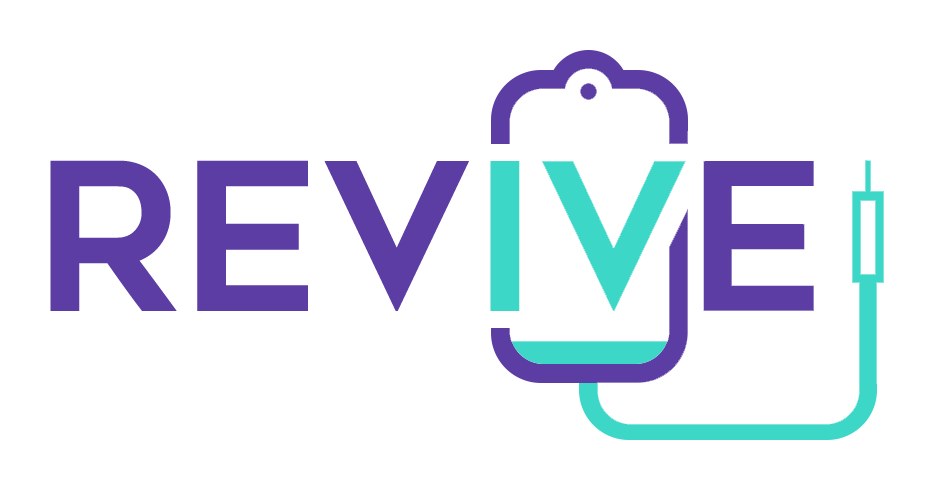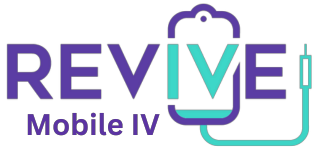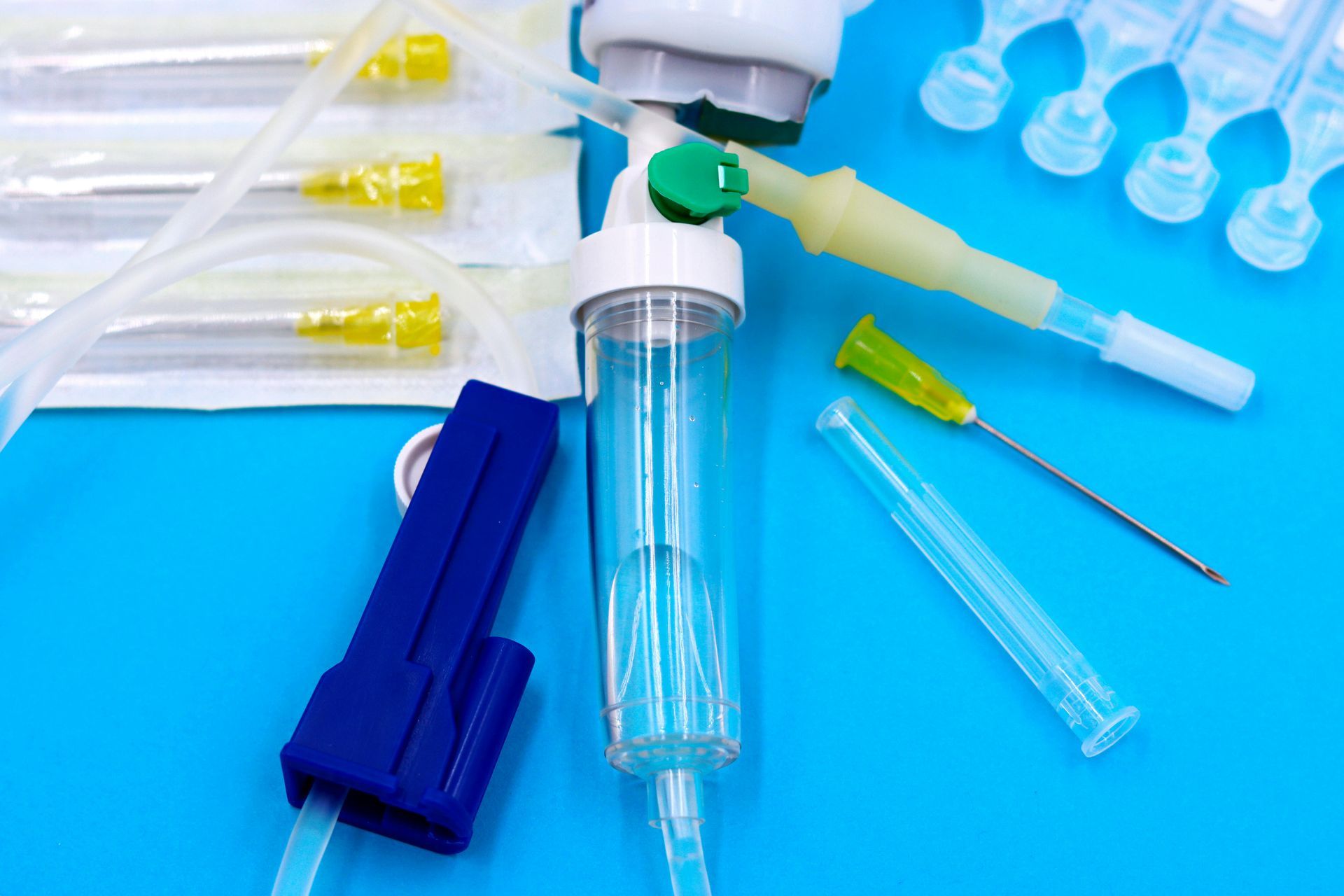IV Migraine Treatment: Rapid Relief for Severe Headaches at Home
When Migraines Strike: The IV Solution
IV migraine treatment delivers medications and fluids directly into your bloodstream for faster relief than oral options. Here's what you need to know:
- What it is: Intravenous therapy that bypasses the digestive system to deliver anti-migraine medications, fluids, and nutrients
- How fast it works: Relief typically begins within 30-60 minutes (vs. 1-2 hours for oral medications)
- Common ingredients: Saline, NSAIDs (like ketorolac/Toradol), anti-nausea medications, magnesium, and B vitamins
- Best for: Severe migraines unresponsive to oral medications, patients with nausea/vomiting, or those needing rapid relief
- Available at: Emergency departments, outpatient infusion centers, or through mobile IV services at home
For the 39 million Americans who suffer from migraines, finding effective relief can be life-changing. When the world is spinning, lights feel like daggers, and the throbbing won't stop, oral medications often fall short – especially when nausea makes swallowing pills nearly impossible.
IV migraine treatment offers a solution by delivering medications directly to where they're needed, bypassing the digestive system that slows down traditional treatments. This approach isn't just about speed – it's about effectiveness when other options have failed.
I'm Kylee Beck, founder of RevIVe Mobile IV, and I've witnessed how IV migraine treatment can transform lives by providing fast, effective relief when patients need it most. As a healthcare professional dedicated to making wellness accessible, I've helped develop protocols that bring this hospital-grade therapy directly to patients' homes across Pennsylvania.
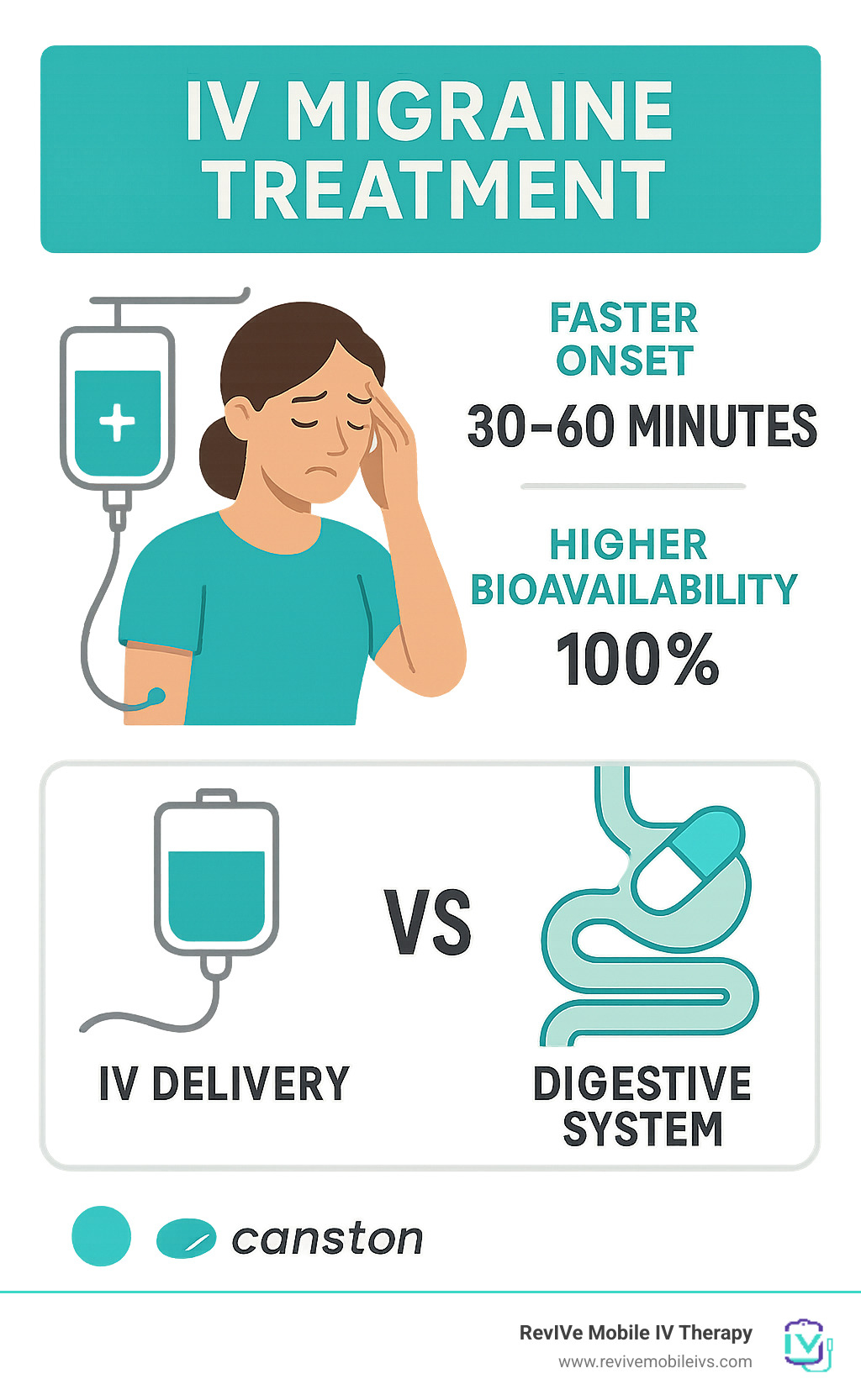
IV Migraine Treatment 101: How the Drip Defeats the Throb
When the world is spinning and your head feels like it's in a vice grip, IV migraine treatment can be your saving grace. But what exactly is this therapy that so many migraine sufferers swear by?
At its core, IV migraine treatment delivers powerful medications and hydration directly into your bloodstream through a small intravenous line. Unlike pills that take a detour through your digestive system, IV therapy takes the express route straight to where it's needed most—your brain.
Migraines aren't just bad headaches—they're complex neurological storms. During an attack, your brain releases inflammatory chemicals and activates pain pathways, with the calcitonin gene-related peptide (CGRP) pathway playing a starring role in your misery. For those trapped in the nightmare of status migrainosus—a migraine that refuses to leave for more than 72 hours—or dealing with severe nausea that makes swallowing pills impossible, IV migraine treatment can be life-changing.

How IV Migraine Treatment Works
The magic of IV migraine treatment happens through several powerful mechanisms. First, medications enter your bloodstream instantly, not an hour or two later like with pills. This rapid absorption means relief starts in minutes, not hours.
Anti-inflammatory medications like ketorolac quickly calm the neuroinflammation raging in your brain, while other medications help normalize those dilated blood vessels contributing to your pain. Many IV cocktails also help restore serotonin balance, a key player in migraine pathways.
Perhaps most underappreciated is the hydration boost. Many migraine sufferers are walking around dehydrated—a common trigger—and IV fluids provide rapid rehydration that drinking water simply can't match during a severe attack.
Think of IV migraine treatment as a multi-pronged attack on your migraine, interrupting the pain cycle at several points simultaneously rather than just taking a single approach.
Who Should (and Shouldn't) Get IV Migraine Treatment
You might be perfect for IV migraine treatment if you're dealing with stubborn migraines that laugh off your usual pills, if you're hugging the toilet with nausea too severe to keep medication down, or if you're trapped in a migraine marathon lasting more than three days. It's also ideal if you're dehydrated or simply need fast relief without an ER visit.
However, this therapy isn't for everyone. If you're pregnant, have heart disease, or deal with kidney or liver problems, certain IV medications might pose risks. Those with allergies to components in the IV cocktail or conditions like Raynaud's phenomenon should proceed with caution.
Safety first: proper screening before treatment is essential. This typically includes reviewing your medical history, current medications, allergies, and sometimes checking vital signs or lab values to ensure you'll benefit without complications.
IV Migraine Treatment vs Pills & Injectables
When comparing your migraine-fighting options, IV migraine treatment stands out in several key ways:
| Feature | IV Treatment | Oral Medications | Injectable Medications |
|---|---|---|---|
| Onset of Action | 30-60 minutes | 1-2+ hours | 30-90 minutes |
| Bioavailability | Nearly 100% | 20-50% (varies) | 70-90% |
| Effectiveness for Severe Attacks | High | Moderate | Moderate to High |
| Useful with Severe Nausea/Vomiting | Yes | Limited | Yes |
| Duration of Effect | Up to 24 hours or more | 4-24 hours | 4-24 hours |
| Administration Complexity | Requires trained professional | Self-administered | Self-administered or professional |
While oral medications like NSAIDs and triptans work well for mild to moderate migraines, they often fall short when you're deep in the throes of a severe attack. Even newer oral CGRP antagonists (gepants) face the same challenge—they still need to survive your digestive system to work.
Injectable options deliver faster relief than pills, but they still don't match the comprehensive approach of a well-designed IV protocol that addresses multiple aspects of your migraine simultaneously.
With IV migraine treatment, you're not just treating symptoms—you're giving your body exactly what it needs to break the migraine cycle, delivered exactly where it needs to go. And when you're suffering, that direct approach can make all the difference between another day lost to pain and getting back to your life.
Inside the IV Bag: Medications, Cocktails & Protocols
Ever wonder what's actually flowing through that IV line when you're getting migraine relief? Let's peek inside the bag and find the powerful combination of medications that can turn your migraine day around.
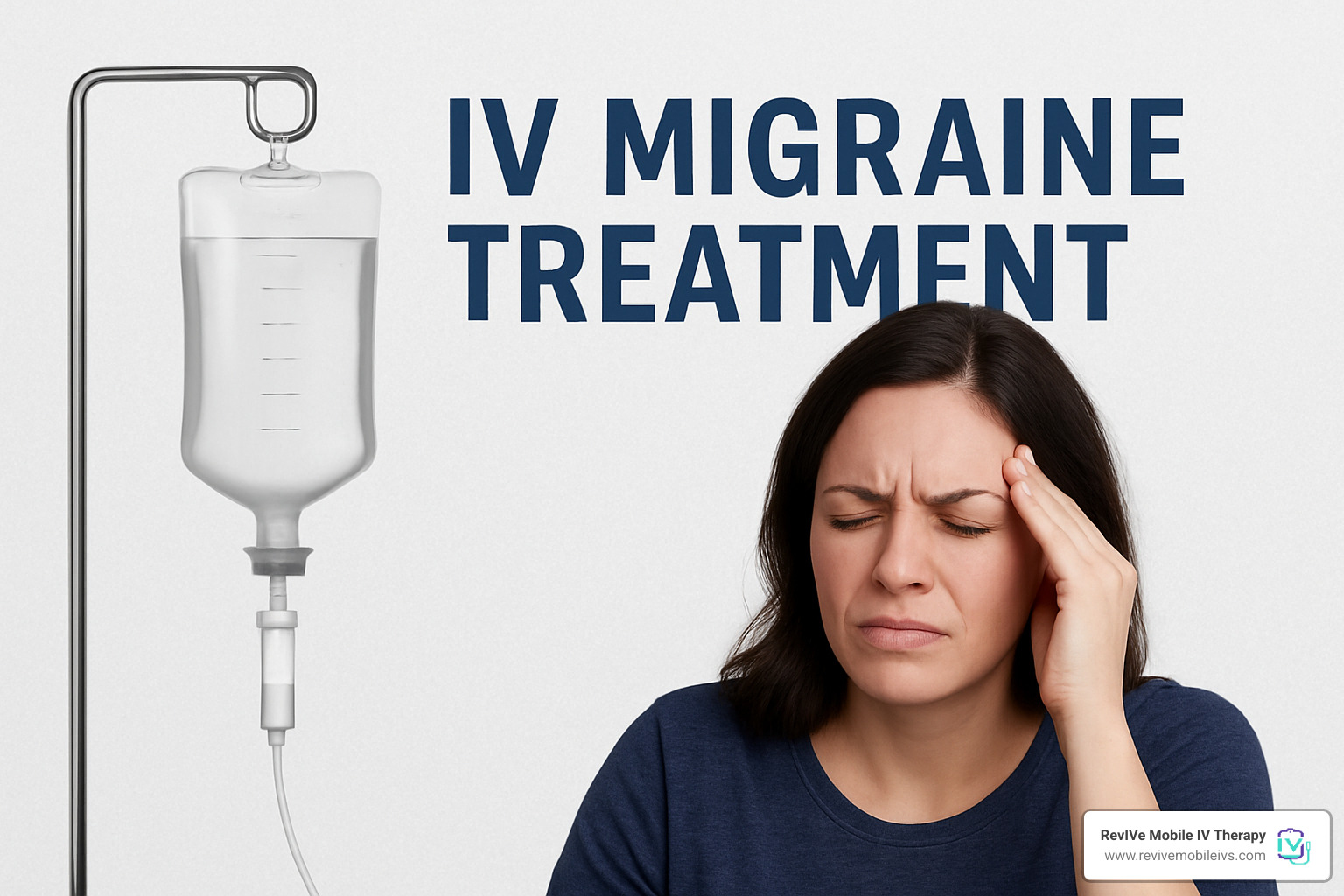
When it comes to IV migraine treatment, there's no one-size-fits-all solution. Your IV cocktail is typically customized based on your symptoms, medical history, and what's worked for you in the past.
Most effective treatments include a powerful NSAID called ketorolac (Toradol) at 15-30 mg to tackle inflammation and pain. Magnesium sulfate(500-1000 mg) helps relax those angry blood vessels and calm overexcited neurons that contribute to your migraine storm.
For that awful nausea that often accompanies migraines, medications like metoclopramide (Reglan) or prochlorperazine (Compazine) at around 10 mg not only settle your stomach but also have their own migraine-fighting properties. We often pair these with diphenhydramine (Benadryl) at 25-50 mg to prevent side effects while providing gentle sedation that can help you rest.
In more stubborn cases, your provider might add dihydroergotamine (DHE) at 0.5-1 mg to constrict those dilated brain blood vessels, or valproate sodium(500-1000 mg) which, though primarily an epilepsy medication, has proven effective for migraine relief. Dexamethasone, a corticosteroid given at 4-10 mg, is particularly helpful in preventing that dreaded migraine rebound.
Of course, we can't forget the foundation of any good IV migraine treatment – hydration! One to two liters of normal saline can address dehydration, which is both a common trigger and aggravating factor for migraines. Some protocols also include vitamins like B2 and C for their antioxidant properties and potential preventive benefits.
For those seeking cutting-edge preventive treatment, eptinezumab (Vyepti) represents the newest class of migraine medications delivered intravenously.
Classic "Migraine Cocktail" Breakdown
The term "migraine cocktail" might sound like something you'd order at a bar, but this particular mixture aims to end pain, not start a party. A classic migraine cocktail combines several key medications that work together to provide comprehensive relief.
At its core, the cocktail typically contains an NSAID for pain and inflammation(usually ketorolac), an antiemetic for nausea(like metoclopramide), and an antihistamine(commonly diphenhydramine) to prevent side effects and provide mild sedation. All of this is delivered in IV fluids to rehydrate your system.
This powerful combination addresses multiple aspects of your migraine simultaneously – like calling in the cavalry, the navy, and the air force all at once to defeat your headache. The synergistic effect often provides much greater relief than any single medication could deliver alone.
In practice, you might receive a liter of normal saline infused over 1-2 hours, with ketorolac, metoclopramide, and diphenhydramine administered as separate "pushes" through your IV line. For those with particularly severe or stubborn migraines, your provider might add magnesium sulfate or dexamethasone to the regimen.
Spotlight on Vyepti & Other CGRP Inhibitors
One of the most exciting developments in IV migraine treatment is the introduction of CGRP inhibitors, with Vyepti (eptinezumab) leading the way as the first FDA-approved intravenous option in this category.
Unlike the medications in traditional migraine cocktails that treat attacks in progress, Vyepti takes a preventive approach. It works by targeting CGRP, a protein that's a key player in causing migraine pain, and blocks it from attaching to receptors in your brain.
What makes Vyepti particularly appealing is its convenience – just one 30-minute infusion every three months. Clinical trials showed impressive results, with 75% of patients experiencing fewer migraines throughout the entire 3-month period between treatments.
While Vyepti represents a breakthrough for many, it's important to be aware of potential hypersensitivity reactions. As with any medication, any adverse events should be reported to the FDA MedWatch program at https://www.fda.gov/safety/medwatch-fda-safety-information-and-adverse-event-reporting-program.
While other CGRP inhibitors are available as injections or pills, Vyepti remains the only IV option, making it ideal for those who prefer less frequent dosing or struggle with self-injections.
Customizing Your Drip
At RevIVe Mobile IV Therapy, we believe your migraine treatment should be as unique as you are. We take the time to understand your specific trigger patterns, symptom profile, and medical history before designing your IV migraine treatment.
If nausea is your nemesis, we might boost the antiemetic component. If you're severely dehydrated (which can both trigger and worsen migraines), we can adjust your fluid volume accordingly. Our physician-led team considers everything from your previous medication responses to your current electrolyte status when crafting your treatment plan.
For our patients who battle frequent migraines, we've developed The Migraine Minimizer , a specially formulated IV treatment designed not just for immediate relief but to support long-term migraine management.
The beauty of IV migraine treatment is its flexibility – we can fine-tune the cocktail to address your specific migraine profile, giving you the best chance for quick, effective relief when you need it most.
Relief Timeline, Benefits & Risks
One of the most welcome surprises for first-time IV migraine treatment patients is just how quickly relief begins to set in. While you've likely spent hours waiting for oral medications to kick in during past attacks, most people start feeling improvement within just 30-60 minutes of beginning their IV infusion – a game-changer when every minute of a migraine feels like an eternity.
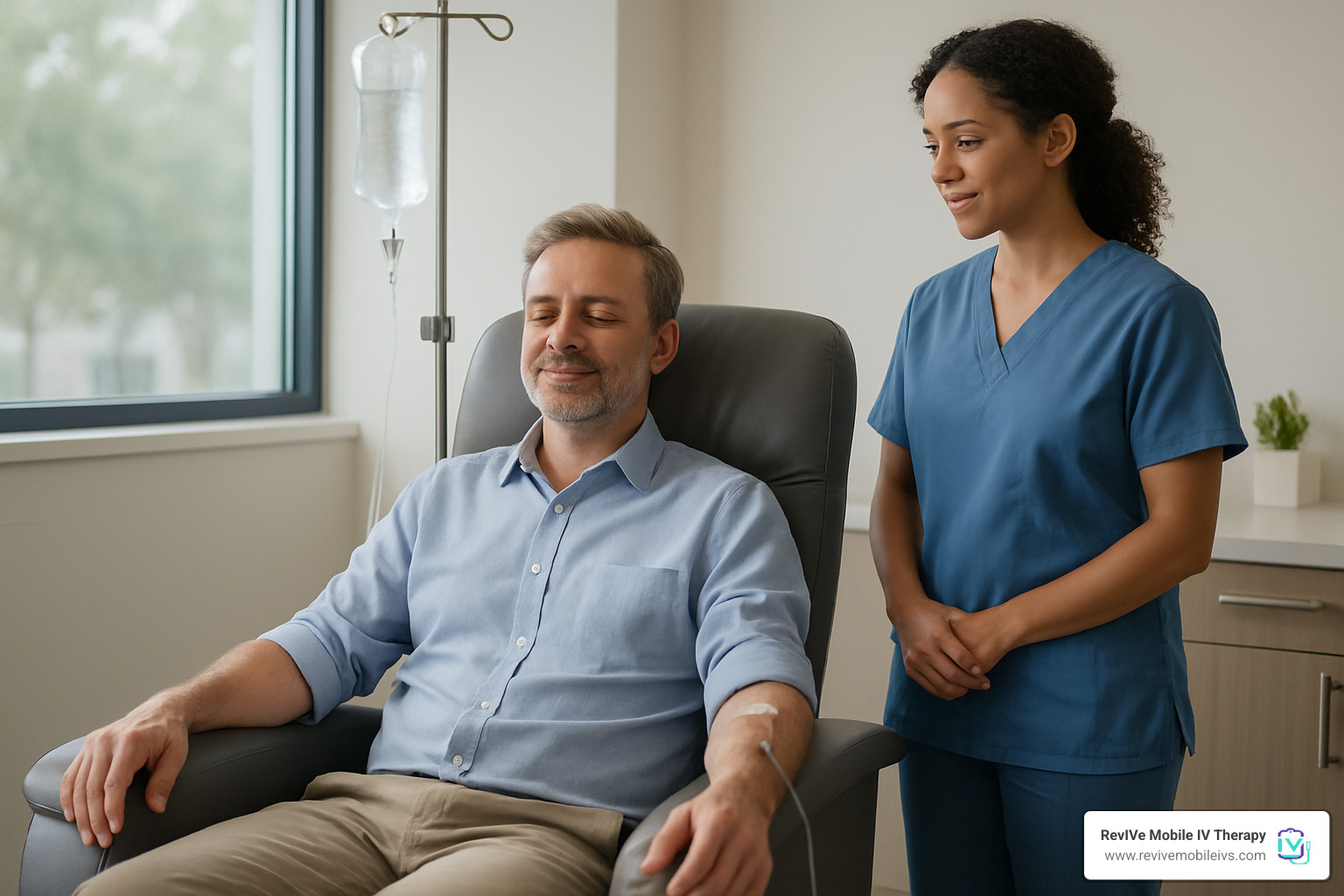
How long will your relief last? That's where things get personal. For some of our patients receiving a standard migraine cocktail, the benefits typically carry them through 24-72 hours of blessed normalcy. But we've seen even more impressive results in many cases – a single treatment can actually break an entire cycle of recurring migraines, giving you weeks between episodes instead of days. And if you're receiving preventive treatments like Vyepti (eptinezumab), you might enjoy reduced migraine frequency for up to 3 full months.
Beyond simply quieting the throbbing in your head, IV migraine treatment offers several life-enhancing benefits that our patients treasure. First, there's the ER avoidance factor – being able to receive professional-grade treatment at home means no more fluorescent-lit waiting rooms when you're at your most vulnerable. The comprehensive approach targets not just your pain but also the nausea, light sensitivity, and other symptoms that make migraines so debilitating.
The hydration component itself is therapeutic, addressing dehydration that might have triggered your migraine or resulted from hours of nausea. For patients who've tried everything else without success, IV migraine treatment often provides that elusive breakthrough when other approaches have failed. Perhaps most importantly, effective treatment of severe attacks can help break the dangerous cycle of medication overuse that leads many sufferers into chronic daily headaches.
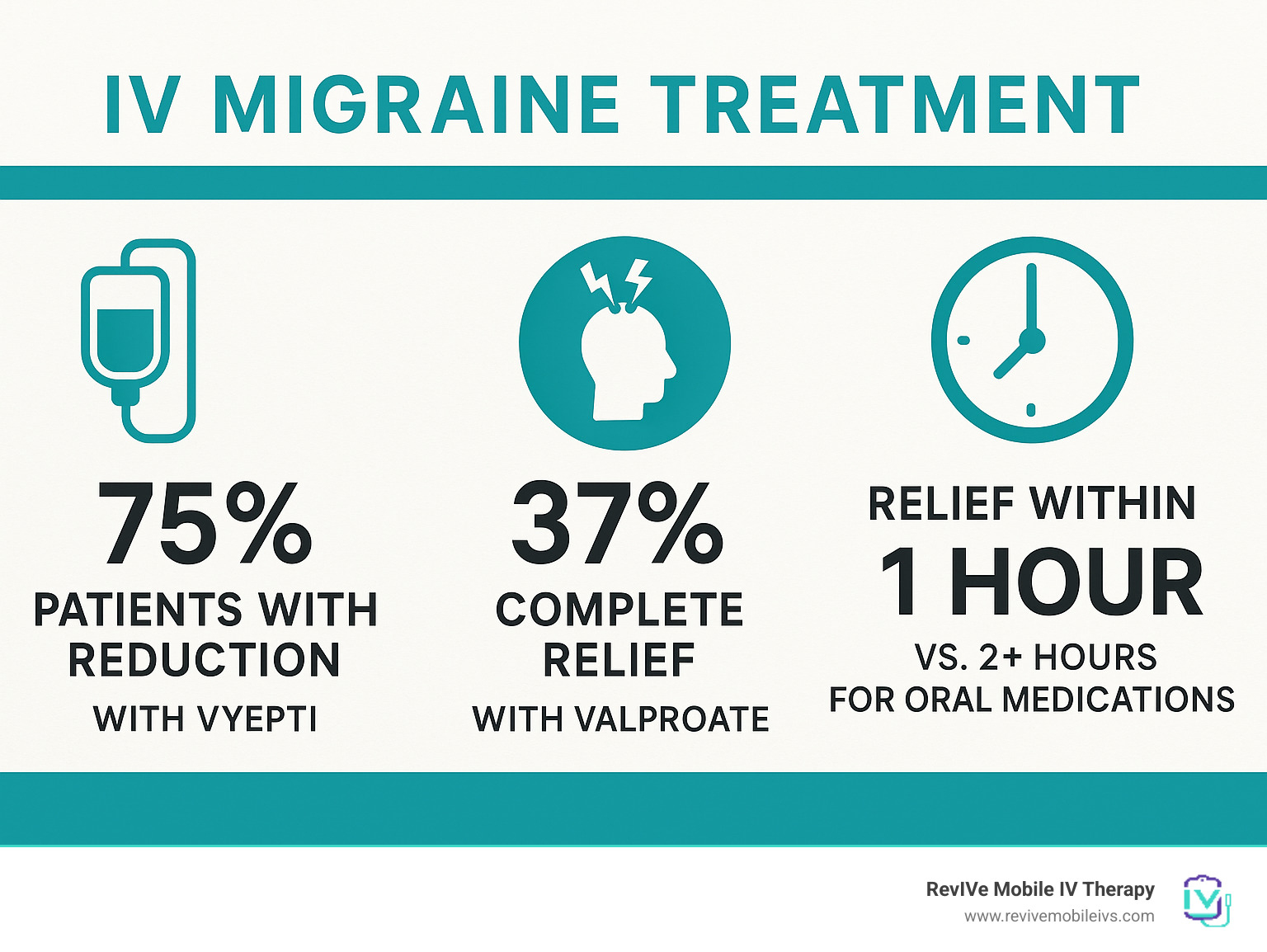
What to Expect During an IV Migraine Treatment Session
"What exactly happens during treatment?" is one of our most common questions from new patients. Let me walk you through the experience, whether you're visiting an infusion center or welcoming our mobile team into your home.
We'll start with a brief but thorough assessment – checking your vital signs and discussing your current symptoms, medical history, and medications. Think of this as our opportunity to fine-tune your treatment plan right before delivery.
Next comes cannulation – the fancy medical term for placing your IV. Our experienced nurses are experts at making this step as comfortable as possible. Most patients are pleasantly surprised by how minimal the discomfort is – especially compared to the migraine pain they're experiencing. We typically place the small IV catheter in your arm or hand, using techniques that prioritize your comfort.
The heart of your visit is the medication administration phase. Some medications in your customized protocol may be given as a quick "push," while others will be infused slowly over 15-60 minutes. Throughout this process, our nurse stays with you, monitoring for any signs of adverse reactions and ensuring your comfort. This is actually a great time to close your eyes, relax in a dark, quiet space, and let the medications do their work.
After the infusion is complete, we'll carefully remove the IV, provide any follow-up care instructions, and answer any questions you might have. Most of our patients can resume normal activities immediately, though some experience mild drowsiness depending on which medications were included in their protocol.
The entire process typically takes between 45-90 minutes – time well spent when it means hours or days of migraine relief. Our RevIVe Mobile IV Therapy patients particularly appreciate receiving treatment in their own homes, avoiding the sensory triggers and stress of medical facilities that can actually worsen migraine symptoms.
Potential Risks & Side-Effects of IV Migraine Treatment
While IV migraine treatment offers powerful benefits, it's important to have a realistic understanding of potential side effects. When administered by trained professionals (like our ER-experienced nurses), these treatments are generally very safe, but no medical intervention is completely without risk.
Most patients might experience mild, temporary effects like a warming or flushing sensation during the infusion, slight dizziness as medications take effect, or minor bruising at the IV site. If your protocol includes diphenhydramine (Benadryl), you might feel drowsy afterward – some patients actually welcome this effect if they've been unable to rest due to pain. With certain medications like Vyepti, some people notice mild cold-like symptoms, and transient blood pressure changes can occur with several of the common migraine medications.
Though less common, we watch carefully for more significant concerns. These might include allergic reactions to medications, substantial blood pressure changes, or extrapyramidal symptoms (unusual movements or restlessness) that can occasionally occur with antiemetic medications. People with Raynaud's phenomenon should be aware that some migraine medications may temporarily worsen their symptoms, and those with kidney issues need special monitoring to avoid renal stress.
It's worth noting that our IV migraine treatment protocols intentionally avoid opioids. This is an important distinction from some emergency department approaches. We've made this choice because opioids carry potential for dependence and are associated with medication overuse headaches – problems we're trying to help you avoid, not create.
At RevIVe Mobile IV Therapy, our nurses don't just administer treatments – they're vigilant monitors trained to identify and manage any side effects that might emerge. Your safety remains our primary concern throughout the entire process, and we take all necessary precautions to ensure your experience is both effective and positive.
Practical Matters: Access, Cost & Safety Logistics
Getting IV migraine treatment shouldn't add stress to an already painful situation. Whether you're wondering where to go, how much it might cost, or how safe the procedure is, let's break down the practical side of this therapy.
You can access IV migraine treatment in several places, each with their own unique benefits:
Emergency rooms are often where people end up during unbearable migraines, but they come with bright lights, long waits, and hefty bills—not ideal when your head is pounding. Outpatient infusion centers offer a calmer setting with specialized care, though you'll still need to travel while fighting migraine symptoms. Then there's the at-home option, where services like ours at RevIVe bring the treatment directly to you, so you can stay in your comfy clothes with the lights dimmed just right.
No matter where you receive treatment, proper medical oversight is crucial. Our approach at RevIVe Mobile IV Therapy ensures every treatment is physician-directed and administered by experienced ER nurses who monitor you throughout the process. Your safety is never compromised for convenience.
When it comes to cost, there's quite a range to consider. An emergency room visit for migraine treatment can easily reach $3,000 or more. Outpatient infusion centers typically charge between $500-$1,500 per session. Mobile IV services generally fall within a similar price range to outpatient centers, but with the added value of not having to leave your home.
Insurance coverage varies widely too. Traditional migraine cocktails in medical settings are often covered (though subject to deductibles and co-pays), while newer treatments like Vyepti usually require pre-authorization. Mobile IV therapy might be out-of-network for many insurance plans, but many of our patients tell us the relief and convenience make the investment worthwhile.
How Often Can IV Migraine Treatment Be Given?
"How frequently can I get this treatment?" is one of the most common questions we hear. The answer depends on both your specific situation and the type of treatment you're receiving.
For standard migraine cocktails that treat acute attacks, you can receive them as needed when severe migraines strike. However, if you find yourself needing treatment more than 2-3 times monthly, it might be time to discuss better preventive strategies with your doctor.
If you're dealing with status migrainosus—those brutal migraines that just won't quit after days—you might benefit from a series of treatments over several days to break the cycle. For preventive treatments like Vyepti, the standard approach is one infusion every three months.
Many of our patients with chronic migraines benefit most from a comprehensive approach: preventive strategies to reduce frequency, combined with rescue treatments for those breakthrough attacks that still manage to sneak through. This balanced approach gives you both everyday protection and a safety net when you need it most.
Getting Treatment Closer to Home
Let's be honest—the last thing you want to do during a migraine is drive to a medical facility. The car ride alone, with its movement, potential traffic, and unavoidable light exposure, can make your symptoms significantly worse.
That's exactly why we created RevIVe Mobile IV Therapy—to eliminate this barrier by bringing IV migraine treatment directly to patients across Pennsylvania. Our service areas include Pittsburgh, Philadelphia, Harrisburg, Lancaster, and many surrounding communities.
We've made accessing treatment refreshingly simple:
- Reach out via phone or our online booking system
- Complete a quick tele-screening with our medical team
- Our ER-trained nurses come to your location, typically the same day
- Receive your customized treatment in your own comfortable environment
- Experience relief without the added stress of traveling to a medical facility
This approach isn't just about comfort (though that's certainly important). Research consistently shows that early intervention for migraine attacks leads to better outcomes. By making treatment more accessible, we help you address migraines before they reach their most debilitating stage.
For more information about the science behind infusion therapy for headaches, the Cleveland Clinic offers excellent research on infusion therapy for headaches that supports this approach.
When you're in pain, the last thing you need is more problems to jump through. That's why we've designed our service to remove as many barriers as possible between you and the relief you deserve.
Frequently Asked Questions About IV Migraine Treatment
How fast will I feel relief?
When you're in the throes of a migraine, minutes feel like hours. The good news is that IV migraine treatment typically begins to ease your symptoms within just 30-60 minutes after starting the infusion. Compare that to the 1-2 hour waiting game with oral medications (which may not even work when you're nauseated), and you can see why so many patients choose the IV route.
Your personal relief timeline depends on a few factors. If you've been battling a migraine for days, it might take a bit longer to feel completely better than if you caught it early. Your body's unique response to the medications plays a role too.
Many of our patients tell us that even before the medications fully kick in, the hydration component alone helps them feel more human again. There's something incredibly restorative about replenishing your body's fluids when dehydration has been contributing to your misery.
Is it covered by insurance?
The insurance landscape for IV migraine treatment can be as complicated as understanding your cell phone bill. Here's the straightforward breakdown:
If you receive treatment in a hospital or outpatient infusion center, your insurance will likely cover it—but expect the usual maze of deductibles, co-insurance, and pre-authorization requirements. Coverage tends to be better when you're experiencing status migrainosus (that nightmare migraine that won't quit after 72+ hours) or when you've already tried other treatments without success.
For preventive treatments like Vyepti, most insurance plans require pre-authorization and may want to see that you've tried and failed other preventive medications first. Don't despair about the cost though—many manufacturers offer helpful co-pay assistance programs to ease the financial burden.
Mobile IV therapy services like ours at RevIVe are often considered out-of-network or cash-pay services. While we can't guarantee insurance reimbursement, we provide detailed documentation that may help you submit claims, especially if you have out-of-network benefits or a health savings account.
We believe in transparency about costs and will always give you clear information before your treatment begins.
Can I combine IV migraine treatment with my current meds?
"Will this interfere with my other medications?" is one of the most common questions we hear. In most cases, IV migraine treatment can peacefully coexist with your regular migraine regimen, but timing and potential interactions deserve careful attention.
If you've recently taken a triptan medication like sumatriptan, we'll need to be cautious about certain IV medications, particularly DHE. These shouldn't be given within 24 hours of each other due to their combined effects on blood vessels.
The good news is that most daily preventive medications—whether you're taking beta-blockers, antidepressants, or anticonvulsants—can continue as scheduled alongside your IV therapy.
Your vitamin and supplement routine is usually fine too. In fact, some of your regular supplements like magnesium and B vitamins might already be included in your IV cocktail for an extra boost.
At RevIVe Mobile IV Therapy, our physician-led team will review every medication and supplement you're taking before your treatment. We take this step seriously—it's not just a box-checking exercise but a crucial part of ensuring your safety and the effectiveness of your treatment.
Always bring a complete list of your medications to your appointment, including those "as needed" rescue medications and any over-the-counter products you use. When it comes to migraine relief, the more information we have, the better we can help you feel better faster.
Conclusion
Living with migraines doesn't mean you have to suffer through attacks or make those dreaded emergency room visits. IV migraine treatment offers a powerful option for quick, effective relief—especially when pills aren't working or when you're too nauseated to keep anything down.
The truth is, successful migraine management usually requires a comprehensive approach. Think of it as building your personal migraine defense system. This includes tracking and avoiding your unique triggers (whether that's certain foods, stress, or weather changes), staying well-hydrated, maintaining consistent sleep patterns, and working closely with healthcare providers on preventive strategies.
But even with the best prevention plan, breakthrough migraines happen. That's where having a reliable rescue option becomes invaluable.
For many Pennsylvanians, knowing they can access mobile IV migraine treatment through RevIVe provides genuine peace of mind. Our service brings hospital-grade care directly to your living room, office, or hotel room—no need to brave bright lights, loud noises, and car rides while your head is pounding. Our physician-led treatments, administered by experienced ER nurses, offer the same quality care you'd receive at a medical facility, but in the comfort of your own space.
IV migraine treatment delivers medications straight to your bloodstream, bypassing the digestive system that often slows relief during an attack. This direct delivery means faster action, better absorption, and more complete relief than what oral or even injectable medications can typically provide.
Whether you're dealing with occasional severe migraines or chronic attacks that disrupt your life regularly, incorporating IV migraine treatment into your management plan could be a game-changer. Many of our patients tell us they finally feel like they have control over their migraines, rather than the other way around.
Ready to explore how IV migraine treatment might fit into your migraine management strategy? Learn more about our migraine services or reach out to discuss your specific situation. With locations serving Pittsburgh, Philadelphia, Harrisburg, Lancaster, and surrounding areas, effective migraine relief may be just one call away.

